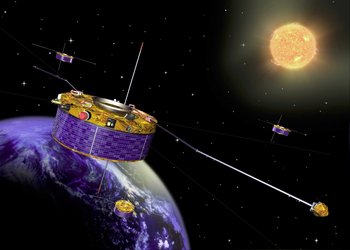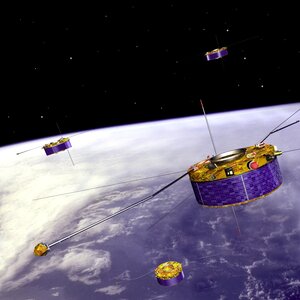Spacecraft
The name Cluster was chosen because of the way the four spacecraft flew in a group around Earth. Cluster came about because studies demonstrated that it would be possible to reuse some parts of the failed Cluster I mission and to fly four spacecraft almost identical to those lost in the first launch. The replacement mission was initially named Cluster II, but now it is generally referred to as Cluster.
Flying in a tetrahedral (triangular pyramid) formation, the four spacecraft collected the most detailed data yet on small-scale changes in near-Earth space, and the interaction between the charged particles of the solar wind and Earth's atmosphere. These data enabled scientists to build a three-dimensional model of the magnetosphere and to better understand the processes taking place inside it.
| Diameter | 2.9 m |
| Height | 1.3 m |
| Mass | 1200 kg |
| (of which) Propellant | 650 kg |
| (of which) Scientific payload | 71 kg |
| Spin rate | 15 rpm |
| Launch date |
16 July, 9 August 2000 Two spacecraft per launch |
| Operational lifetime |
Two years (nominal) Extended to 2005, then to 2009, then to 2012, then finally 2024 Mission ended with the reentry of the first Cluster satellite in September 2024 |
Orbit
The Cluster satellites travelled around Earth in an elliptical polar orbit. The closest they came to Earth was a few hundred kilometres. The furthest was 125 000 km. The time to complete a single orbit was 54 hours 35 minutes.
Instruments
Each of the four spacecraft carried an identical set of 11 instruments to investigate charged particles, electrical and magnetic fields. These were built by European and American instrument teams led by Principal Investigators.
Operations
Spacecraft operations centre: European Space Operations Centre (ESOC), Germany.
Ground stations: Villafranca and Maspalomas, Spain; Perth, Australia; Panska Ves, Czech Republic; along with NASA DSN and other ESA ESTRACK stations.
Science operations centre: Joint Science Operations Centre at the Rutherford Appleton Laboratory, Didcot, UK.















 Germany
Germany
 Austria
Austria
 Belgium
Belgium
 Denmark
Denmark
 Spain
Spain
 Estonia
Estonia
 Finland
Finland
 France
France
 Greece
Greece
 Hungary
Hungary
 Ireland
Ireland
 Italy
Italy
 Luxembourg
Luxembourg
 Norway
Norway
 The Netherlands
The Netherlands
 Poland
Poland
 Portugal
Portugal
 Czechia
Czechia
 Romania
Romania
 United Kingdom
United Kingdom
 Slovenia
Slovenia
 Sweden
Sweden
 Switzerland
Switzerland





























